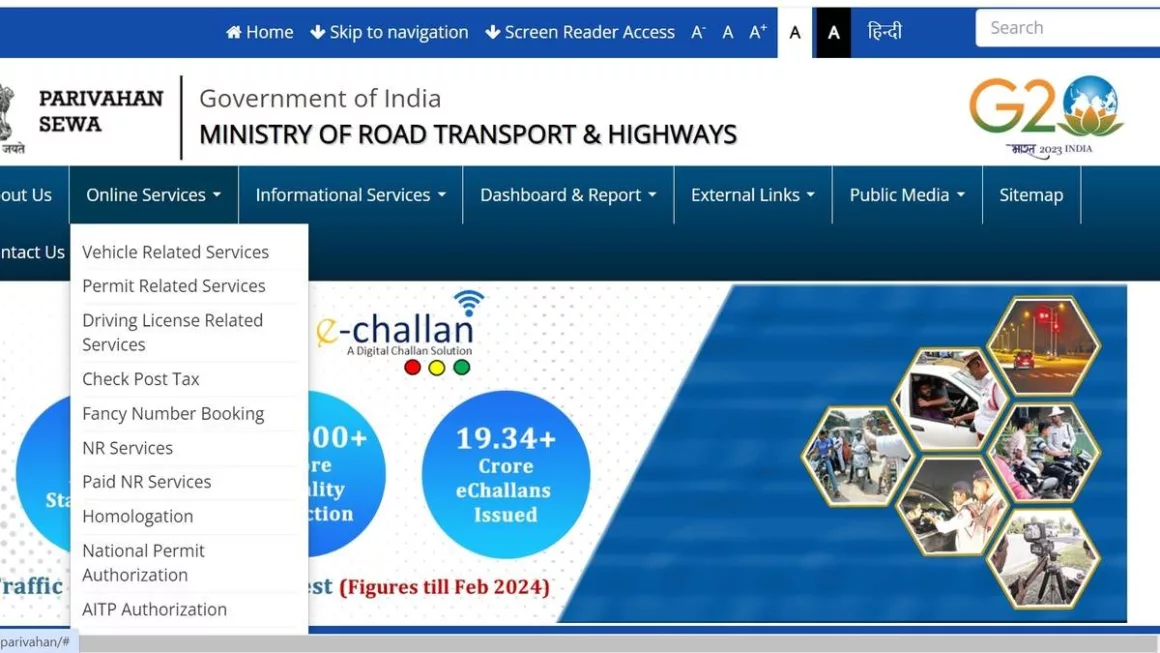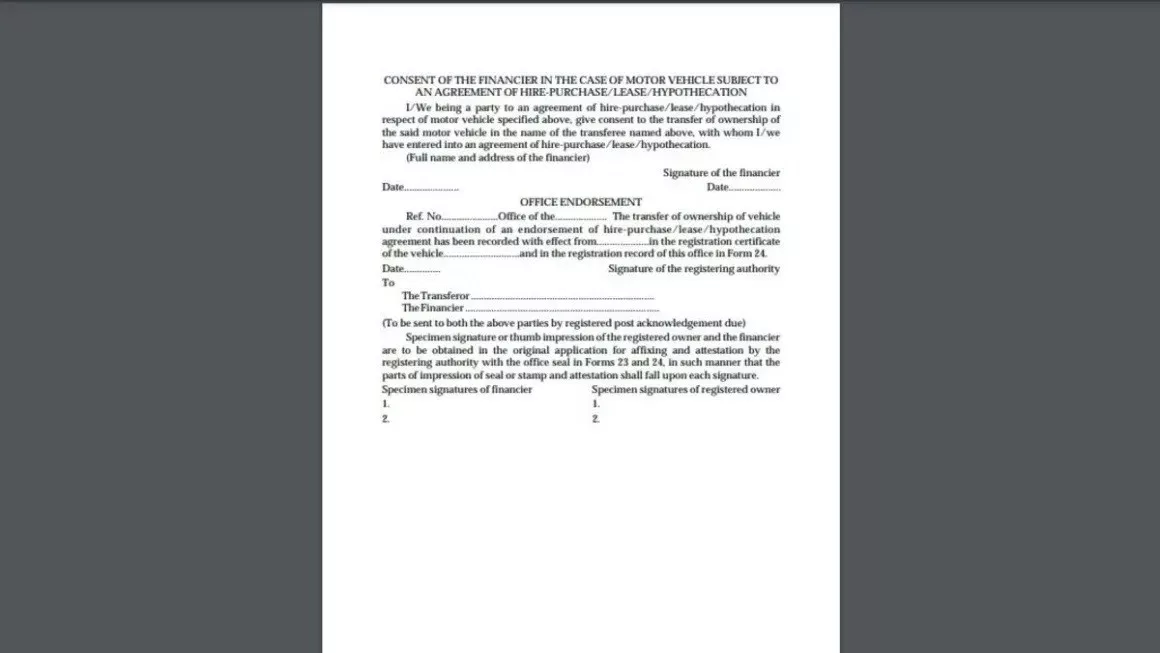Once you purchase a used car, several vital documents are required to ensure a smooth transfer of ownership. One such document is Form 30, which serves to notify the local RTO about the transfer of ownership of a motor vehicle. In accordance with the Motor Vehicles Act of 1988, when selling a car, the owner must submit the Form 30 to the RTO where the car or vehicle was registered initially, following the submission of Form 29.
The Form 30 also stipulates that the new owner should be responsible for all legal liabilities of the car. Thus, two copies of Form 30 are required to be submitted to the local RTO within 14 days from the date of the car sale. This article explains all the requirements and procedures involved in submitting the Form 30 to your local RTO.
Also read: Why is Form 20 required while buying a car: Requirements, How to apply
Table of Contents
- Why is Form 30 required for buying a car?
- How to download Form 30 online?
- Parts of Form 30
- What are the steps to fill out Form 30?
- What documents are required to be submitted along with Form 30 to the RTO?
- Summary
- FAQ
Why is Form 30 required for buying a car?
Submission of Form 30 basically means a confirmation of the submission of Form 29 which is required for the transfer of vehicle ownership. Form 29 initiates the process by notifying the local RTO about the intention to transfer ownership, while Form 30 acts as confirmation that this process should proceed without delay. Together, these forms ensure that the transfer of vehicle ownership is formally acknowledged and legally processed by the authorities.
The Form 30 is required while buying a car because it helps to transfer all the legal obligations associated with the vehicle. It also indicates that the buyer has received all the vehicle certificates, such as the Registration Certificate and the insurance policy paper, which can come in really handy.
Also read: Why is Form 29 required while buying a car: Requirements, How to apply
How to download Form 30 online?
Follow the mentioned steps below in order to download Form 30 online.
- Step 1: Visit the Parivahan website.

- Step 2: Click on the ‘Informational Services’ from the menu bar
- Step 3: From the following drop down menu, select ‘Downloadable Forms’
- Step 4: Click on ‘All Forms’ option from the drop down menu
- Step 5: When a new page opens up, where you can scroll down and download Form 30
Parts of Form 30
There are four sections in Form 30. Part A provides you with all information on the transferor or seller. Part B contains all the information about the transferee or buyer. Part C is all about the financier’s agreement to the transfer of ownership if the vehicle comes under any lease or hypothecation. Part D is an official endorsement by the Registering Authority.
Part A

- Name of the registering authority
- Name of the transferor, father or husband’s name and full address
- Date and year in which the car was sold to the new buyer
- Registration number of the particular vehicle
- Name of the buyer, father or husband’s name and full address
- Signature or thumb impression of the seller or the transferor
Part B

- Name of the transferee or the buyer, his/her father or husband’s name, age, contact number and full address
- Nominee’s name and relation
- Date and year in which the vehicle was sold, registration number, and address from where the car was purchased
- Signature or thumb impression of the buyer/transferee with date
Part C
- The financier’s signature of consent in case the car is sold under a lease or hypothecation. Full name of the financier, address and date is required.
Part D
- Reference number, name of the RTO office, effective date of the transfer of ownership and the vehicle number of the sold car
- Signature of the concerned authority at the RTO is required, date, name of the transferor and the financier.
- Specimen signature for both the financier and the registered owner of the sold car.
Also read: Why is Form 22 required while buying a car: Requirements, How to apply
What are the steps to fill out Form 30?
You can follow the step-by-step procedure to fill out Form 30:
- Step 1 : Firstly, you need to write the name of the Registering authority. The Registering Authority is the authorised person at the local RTO where the vehicle’s ownership transfer will be initiated.
- Step 2: Next, enter the name of the applicant, father’s/husband’s name, and the applicant’s address.
- Step 3: Mention the date and year in which vehicle was sold
- Step 4: Write down the name of the buyer, their father’s/husband’s name ( as applicable), the buyer’s address and the registration number of the sold vehicle.
Note: The seller or transferor must declare below that all documents such as RC and the insurance paper have been handed over to the new buyer. The transferor must also mention that the registering authority has never or not yet cancelled or suspended the RC. The seller should enclose the NOC issued by the Registering Authority. If the NOC is not available at the time of sale, the seller should file for one along with Form 30 application and a declaration as required under sub-section (1) of section 50.
- Step 5: Next, the transferor will affix his/her signature or thumb impression at the last portion of part A
- Step 6: The part B of Form 30 gives details of the transferee. You need to mention the name of the buyer, his/her father’s name or husband’s name, age, mobile no. and full address.
- Step 7: Mention the nominee’s name and the relation
- Step 8: Next, write the date and year on which the vehicle was bought, and also mention the registration number of the vehicle and the address from where it was purchased.
- Step 9: A thumb impression or a signature is required here along with the date of the transferee/buyer
- Step 10: In case the sold car is under a lease, hire purchase, or hypothecation agreement, the financier must set his signature on the form, validating his consent to the transfer of ownership of the concerned vehicle under part C. The financier’s full name, address and date must also be mentioned herein the space provided.
- Step 11: Now, in the part D of Form 30, the Registering Authority representative must enter the reference number, the office of the RTO, the effective date of the transfer of ownership and the vehicle number. The concerned authority at the RTO will add his signature and date, as well as mention the transferor and the financier’s name. Both the parties – the transferor and the financier will receive a copy of this document via registered mail.
- Step 12: At the end, specimen signatures of the financier and the registered owner must be affixed on the form.
Note: The specimen signature or thumb impression of the registered owner and the financier must be obtained in the original application. This will be attested by the registering authority with their office seal in Forms 23 and 24. The seal or stamp and attestation should fall upon each of the signatures.
What documents are required to be submitted along with Form 30 to the RTO?
Documents required to be submitted along with Form 30 to the RTO are:
- Name and address proof of the owner and buyer
- Buyer’s age proof
- Insurance copy
- Vehicle registration certificate
- Vehicle Fitness certificate
- NOC provided by the Registering Authority
Also read: Why is an Aadhaar card required while buying a car: Requirements, How to apply.
Summary
RTO Form 30 is essential for notifying and transferring ownership of a motor vehicle. It is the application required to inform authorities about the change in ownership and confirms the submission of Form 29. This process facilitates the transfer of legal responsibilities and ownership from the current owner to the new buyer. Form 30 also helps to verify that the transferor or the owner of the used car has given the transferee or the new buyer the Registration Certificate and the Insurance copy paper. Refer to the article above to get a clear and thorough understanding of how to effectively fill out Form 30.
FAQ
Q: Why is Form 30 important?
A: The seller must ensure that they submit Form 30 to confirm the submission of Form 29 to the RTO. Form 30 is mainly used to inform RTO that a particular vehicle in their jurisdiction is sold and its new owner holds all its legal obligations. One must submit Form 30 within 14 days after the vehicle is sold.
Q: What is the meaning of transferor in the Form 30?
A: The transferor, who is the current owner of the vehicle, should fill out the relevant sections of Form 30, provide their personal details, vehicle information, and reason for the proposed transfer. They should also sign the form to provide their consent for their ownership transfer.
Q: Who needs Form 30 and is it available both online and offline?
A: Anyone who wants to sell their car needs to submit Form 30 after the submission of Form 29 to complete the process of transfer of vehicle owner ownership. Yes, Form 30 is available for both offline and online. You should be able to download Form 30 from the Parivahan website or collect it from the local RTO.
Q: What are the documents required to be submitted along with Form 30?
A: You would require the following documents to submit along with the Form 30:
ID and Address Proof of the seller
ID and Address proof of the buyer
Age proof of the buyer
Registration certificate
NOC by RTO
Vehicle Fitness Certificate
Insurance CertificateQ: What are the important factors that need to be considered while filling out Form 30?
A: To complete Form 30, it’s important to verify whether the vehicle is under lease or hypothecation. Secondly, the signature or the thumb impression of the original owner and the financier is necessary to be there to complete the filling out of the Form 30. Also, the official seal of the Registering Authority must be put in such a way that part of the stamp imprint remains on each signature.


 ne big family!
ne big family!